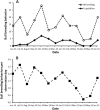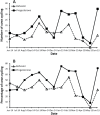Effects of prolonged immunocontraception on the breeding behavior of American bison
- PMID: 29674785
- PMCID: PMC5901074
- DOI: 10.1093/jmammal/gyx087
Effects of prolonged immunocontraception on the breeding behavior of American bison
Abstract
In late 2009, the Catalina Island Conservancy began using fertility control to replace periodic removals to manage an introduced population of American bison (Bison bison) on the island. Through the application of the immunocontraceptive vaccine porcine zona pellucida (PZP), population growth was slowed within 1 year, and halted over time. In response to lingering questions about the use of PZP to manage large, free-ranging wildlife populations, we sought to determine the reversibility of PZP by ceasing the annual application to a subset of 15 bison cows and monitoring for subsequent calf arrival, and to document changes in the timing and length of the breeding season in response to PZP by monitoring breeding behavior and assessing fecal progesterone (FP) levels for all 60 resident cows over a 13-month period. As of June 2017, no new calves had been observed on the island, suggesting that, following repeated annual treatment with PZP (3 or 4 years), bison do not resume normal reproduction for at least 4 or 5 years, and that fewer treatments would be advisable if a faster return to fertility is desired. Based on observations of bull and cow behavior, and FP levels, cows displayed estrous cycles consistently throughout the study period, indicating that bison may ovulate year-round when conception and its consequences, e.g., lactation and presence of calves, are blocked. Because there is little evidence that an extended breeding season would negatively impact the health of bulls or result in large numbers of out-of-season births on Catalina, PZP appears to be a highly effective tool for managing the population of introduced bison on the island. However, the extended period of contraception and breeding activity of both cows and bulls may make PZP less suitable in high-latitude, predator-rich environments where bison conservation remains a top priority.
Keywords: Bison bison; Catalina Island; PZP; immunocontraception; non-lethal population control; reproductive behavior.
Figures




Similar articles
-
Romance without responsibilities: the use of the immunocontraceptive porcine zona pellucida to manage free-ranging bison (Bison bison) on Catalina Island, California, USA.J Zoo Wildl Med. 2013 Dec;44(4 Suppl):S123-31. doi: 10.1638/1042-7260-44.4S.S123. J Zoo Wildl Med. 2013. PMID: 24437092
-
Immunocontraception in wild horses (Equus caballus) extends reproductive cycling beyond the normal breeding season.PLoS One. 2010 Oct 26;5(10):e13635. doi: 10.1371/journal.pone.0013635. PLoS One. 2010. PMID: 21049017 Free PMC article.
-
Preliminary evaluation of porcine zona pellucida (PZP) immunocontraception for behavioral effects in feral horses (Equus caballus).J Appl Anim Welf Sci. 1999;2(4):321-35. doi: 10.1207/s15327604jaws0204_6. J Appl Anim Welf Sci. 1999. PMID: 16363936
-
Researching immunocontraceptive vaccines with mares (Equus caballus) as both a target and model for African elephant (Loxodonta africana) cows: A review.Anim Reprod Sci. 2019 Aug;207:146-152. doi: 10.1016/j.anireprosci.2019.06.002. Epub 2019 Jun 4. Anim Reprod Sci. 2019. PMID: 31208844 Review.
-
Case studies in wildlife immunocontraception: wild and feral equids and white-tailed deer.Reprod Fertil Dev. 1997;9(1):105-10. doi: 10.1071/r96052. Reprod Fertil Dev. 1997. PMID: 9109199 Review.
Cited by
-
Immunocontraceptive Efficacy of Native Porcine Zona Pellucida (pZP) Treatment of Nevada's Virginia Range Free-Roaming Horse Population.Vaccines (Basel). 2024 Jan 18;12(1):96. doi: 10.3390/vaccines12010096. Vaccines (Basel). 2024. PMID: 38250909 Free PMC article.
-
Reversible Contraception in Males: An Obtainable Target?Biology (Basel). 2024 Apr 25;13(5):291. doi: 10.3390/biology13050291. Biology (Basel). 2024. PMID: 38785772 Free PMC article. Review.
-
BOARD INVITED REVIEW: Immunocontraception as a possible tool to reduce feral pig populations: recent and future perspectives.J Anim Sci. 2019 May 30;97(6):2283-2290. doi: 10.1093/jas/skz066. J Anim Sci. 2019. PMID: 30753509 Free PMC article. Review.
-
Effects of Porcine Zona Pellucida Immunocontraception on Mare Body Condition and Foaling Season Length in Two Western Wild Horse Populations.Animals (Basel). 2024 Dec 9;14(23):3550. doi: 10.3390/ani14233550. Animals (Basel). 2024. PMID: 39682515 Free PMC article.
References
-
- APHIS [Animal and Plant Health Inspection Service] 2012. Evaluation of GonaCon™, an immunocontraceptive vaccine, as a means of decreasing transmission of Brucella abortus in bison in the Greater Yellowstone Area. U.S. Department of Agriculture, Environmental Assessment, May 2012. Fort Collins, Colorado: .
-
- Asa C. S., and Porton I. J. (eds.). 2005. Wildlife contraception: issues, methods, and applications. John Hopkins University Press, Baltimore, Maryland.
-
- Barber M. R., and Fayrer-Hosken R. A.. 2000. Possible mechanisms of mammalian immunocontraception. Journal of Reproductive Immunology 46: 103–124. - PubMed
-
- Berger J., and Cunningham C.. 1991. Bellows, copulations, and sexual selection in bison (Bison bison). International Society for Behavioral Ecology 2: 1–6.
-
- Berger J., and Cunningham C.. 1994. Bison: mating and conservation in small populations. Columbia University Press; New York.
LinkOut - more resources
Full Text Sources
Other Literature Sources
Research Materials
Miscellaneous

